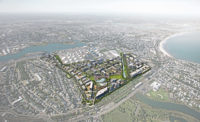The $13.5-billion in total project volume reflected in this year’s ENR MidAtlantic Top Starts list is down sharply from the $21.2 billion posted in the year-ago period, but the previous year’s total was buoyed by seven energy-related megaprojects, led by the $6-billion Shell ethylene cracker plant in Monaca, Pa.
This year, only three energy projects made the list, but the top entry on the ranking is from that sector: the $4.6-billion Mountain Valley natural gas pipeline, whose route runs through Virginia and West Virginia.
Two other energy projects, each valued at $500 million, were tied for the No. 7 slot: the Dominion Transmission Supply Header project in West Virginia and Pennsylvania and the Harmon Creek Natural Gas Processing Plant in Bulger, Pa.
The presence of fewer oil and gas projects on the list this year could be due to “more regulatory scrutiny than was anticipated,” says Dan Faust, AECOM executive vice president for the Southeast region, which includes Maryland, Washington, D.C., Virginia and West Virginia. “It’s less about the market slowing down than the projects themselves probably taking a little bit longer to develop,” Faust says.
|
Related Link |
All of the 25 projects listed this year began substantial construction during 2018. The ranking is compiled using information from Dodge Data & Analytics, plus details provided by firms. The minimum value of this year’s projects—in Delaware, Maryland, Pennsylvania, Virginia, West Virginia and the District of Columbia—was more than $185 million, compared with a $150-million minimum last year.
Architect Shalom Baranes, founding principal at Shalom Baranes Associates, has five projects represented on this year’s list, including the No. 4-ranked City Ridge project at the former Fannie Mae headquarters in Washington, D.C. The $640-million, mixed-use facility, which is expected to be completed in 2022, will include 652 residential units, a 150-room hotel, 62,000 sq ft of office space and the city’s first Wegman’s supermarket. “It is a real hole in the neighborhood that will be filled in a vibrant way,” Baranes says.
Multi-building, mixed-use projects such as City Ridge have been the “bread and butter for most architectural firms in this region in the last 10 years,” he says, but notes that the sector now is tapering off. He says construction is slowing or leveling in “almost every market” in the D.C. area, and he predicts a more dramatic decline by early 2020.
Baranes says the volume of certain types of federal projects is falling faster than for private-sector projects. But Peter J. Downes, program manager at Peter Schwartz Management Co., says the federal development leaseback program remains robust as government consolidation continues at facilities such as the Dept. of Homeland Security’s St. Elizabeths West campus in Southeast D.C.
Under the leaseback program, in which developers provide land, financing, design and construction services for an entire buildout, Downes’ firm is building the No. 17-ranked U.S. Citizenship and Immigration Services (USCIS) project in Camp Springs, Md., which is near the Defense Dept.’s Joint Base Andrews. “The USCIS consolidates six buildings at an overall reduced per square foot cost for the lease,” Downes says. “We anticipate 2 to 3 million square feet of leaseback to be contracted in the next two or three years.”
The only other federal project on the 2019 list is the Smithsonian Institution’s National Air & Space Museum renovation. It was ranked No. 2, at approximately $1 billion. The project includes refacing the Tennessee marble facade, replacing mechanical systems and constructing new exhibits and vestibule and queuing areas.
Despite uncertainty surrounding federal infrastructure funding and with military construction funds possibly being diverted to a wall along the southern border, Faust says work at nonmilitary agencies and disaster-relief projects should keep AECOM busy on the federal front.
Because of the frequency of recent storms and the significant coastal damage they have caused, “I think it’s an area that’s trending up for us,” he says. Administering post-disaster programs and projects that help people “restore to normal” after disasters has been a “huge growth area” for AECOM, Faust says. But he adds, “What we really need to do more of as a nation, region and industry is planning for and building more resilient infrastructure.”
AECOM also is active in the transportation segment, including the No. 3-ranked Frederick Douglass Memorial Bridge over the Anacostia River in Washington; the No. 11 new North Concourse at Ronald Reagan Washington National Airport in Arlington, Va., and No. 13-ranked Phase 4 of Interstate-95/Girard Avenue Interchange construction in Philadelphia. Transportation is “probably our biggest growth market in this part of the world,” Faust says.
Still, Baranes is bracing for an overall slowdown. “A telling sign for me always is how difficult is it to recruit architects,” he says. “We are seeing more résumés come in than we used to. To me that’s indicative of what’s coming.”








Post a comment to this article
Report Abusive Comment